Management Report: Environmental Constraints and Strategic Planning
VerifiedAdded on 2021/01/02
|8
|1854
|75
Report
AI Summary
This report provides a comprehensive analysis of management principles as applied within Microsoft. It begins with an introduction to the importance of management in achieving organizational goals and then delves into the environmental constraints, including specific, general, and global factors, affecting Microsoft's operations. The report examines the company's stakeholders, including customers, suppliers, and employees, and how Microsoft addresses their needs and concerns through corporate social responsibility. It further explores strategic planning, organizational structure, and design, highlighting Microsoft's product-type divisional structure. Finally, the report discusses the foundation of control, covering preventive, detective, and corrective control systems. The conclusion summarizes the key findings and emphasizes the significance of effective management practices in Microsoft's success.
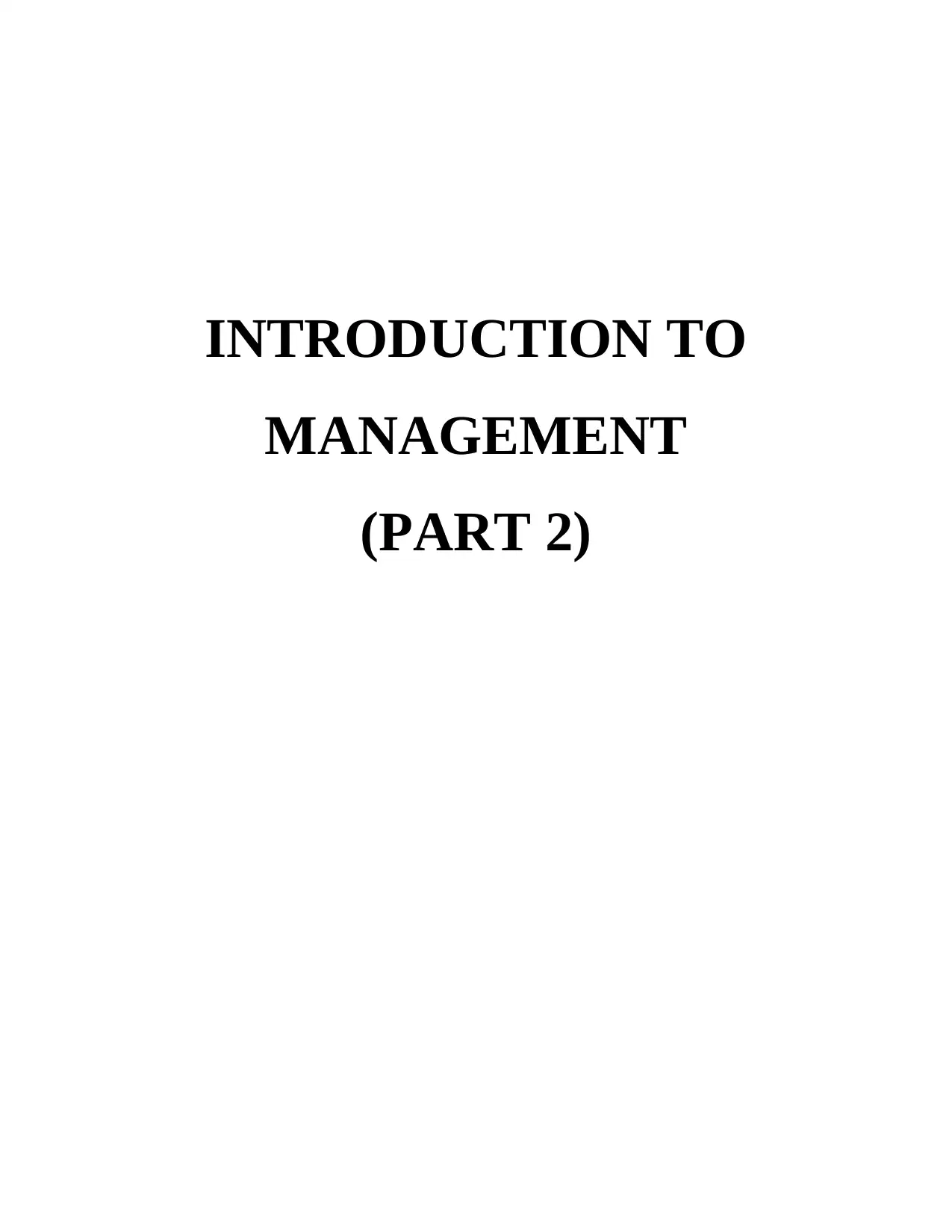
INTRODUCTION TO
MANAGEMENT
(PART 2)
MANAGEMENT
(PART 2)
Paraphrase This Document
Need a fresh take? Get an instant paraphrase of this document with our AI Paraphraser
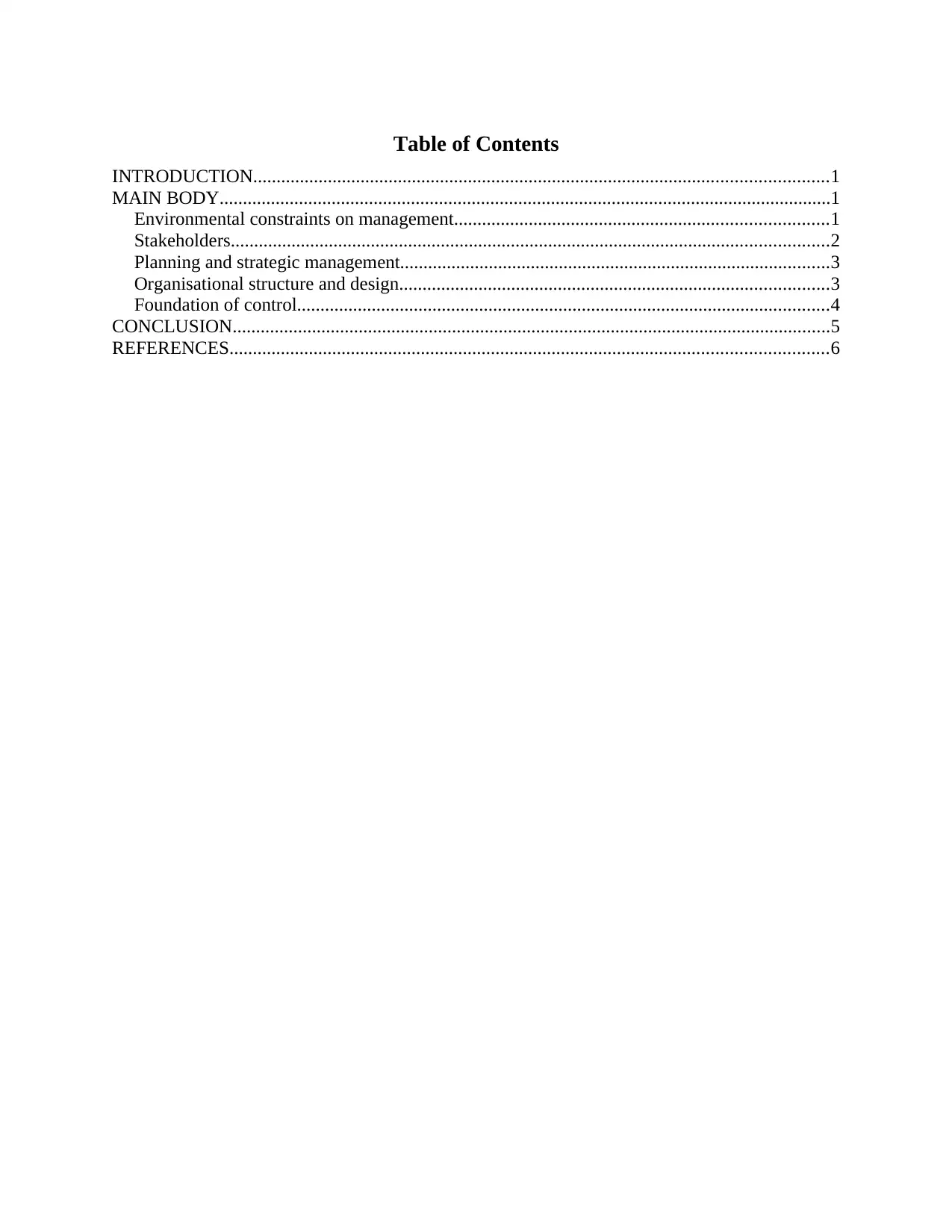
Table of Contents
INTRODUCTION...........................................................................................................................1
MAIN BODY...................................................................................................................................1
Environmental constraints on management................................................................................1
Stakeholders................................................................................................................................2
Planning and strategic management............................................................................................3
Organisational structure and design............................................................................................3
Foundation of control..................................................................................................................4
CONCLUSION................................................................................................................................5
REFERENCES................................................................................................................................6
INTRODUCTION...........................................................................................................................1
MAIN BODY...................................................................................................................................1
Environmental constraints on management................................................................................1
Stakeholders................................................................................................................................2
Planning and strategic management............................................................................................3
Organisational structure and design............................................................................................3
Foundation of control..................................................................................................................4
CONCLUSION................................................................................................................................5
REFERENCES................................................................................................................................6
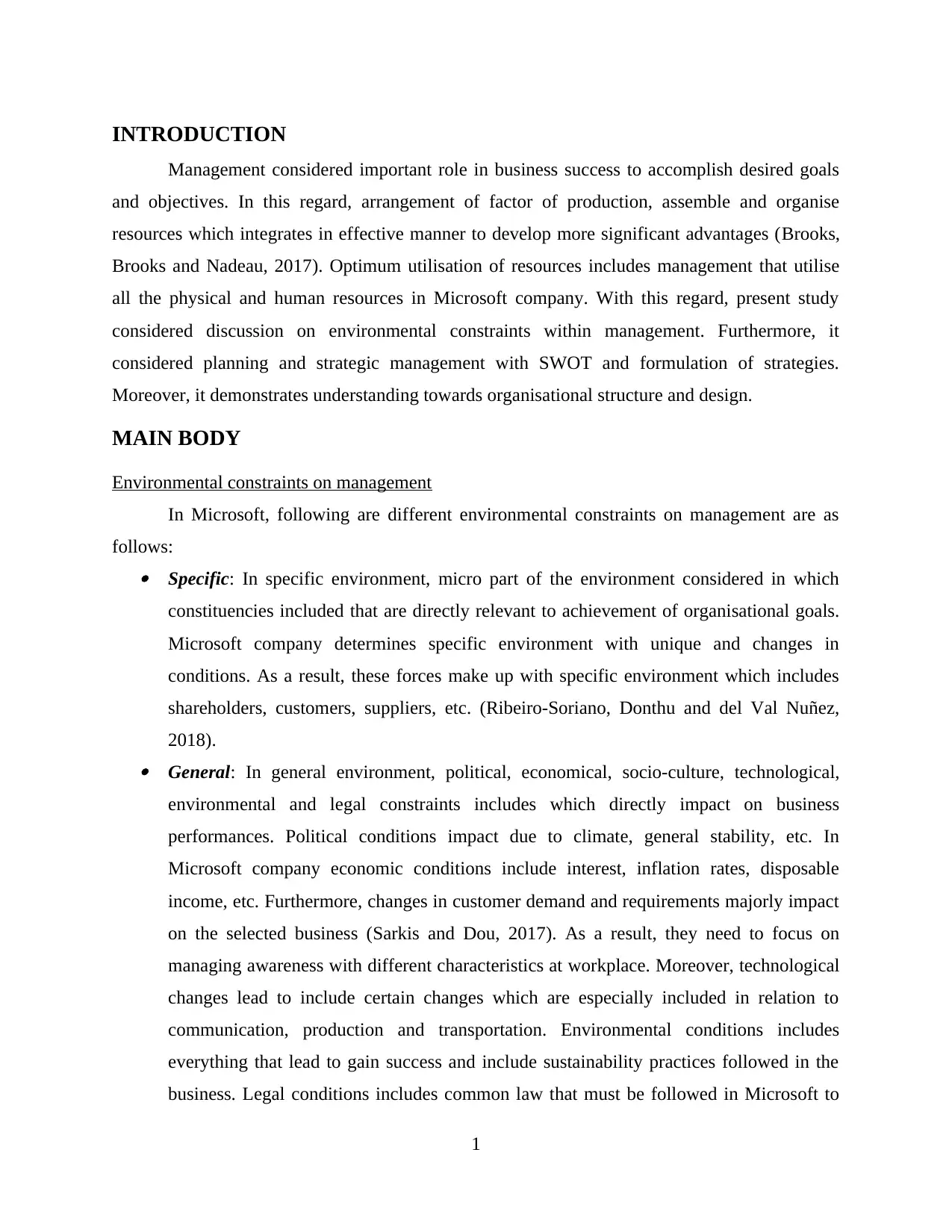
INTRODUCTION
Management considered important role in business success to accomplish desired goals
and objectives. In this regard, arrangement of factor of production, assemble and organise
resources which integrates in effective manner to develop more significant advantages (Brooks,
Brooks and Nadeau, 2017). Optimum utilisation of resources includes management that utilise
all the physical and human resources in Microsoft company. With this regard, present study
considered discussion on environmental constraints within management. Furthermore, it
considered planning and strategic management with SWOT and formulation of strategies.
Moreover, it demonstrates understanding towards organisational structure and design.
MAIN BODY
Environmental constraints on management
In Microsoft, following are different environmental constraints on management are as
follows: Specific: In specific environment, micro part of the environment considered in which
constituencies included that are directly relevant to achievement of organisational goals.
Microsoft company determines specific environment with unique and changes in
conditions. As a result, these forces make up with specific environment which includes
shareholders, customers, suppliers, etc. (Ribeiro-Soriano, Donthu and del Val Nuñez,
2018). General: In general environment, political, economical, socio-culture, technological,
environmental and legal constraints includes which directly impact on business
performances. Political conditions impact due to climate, general stability, etc. In
Microsoft company economic conditions include interest, inflation rates, disposable
income, etc. Furthermore, changes in customer demand and requirements majorly impact
on the selected business (Sarkis and Dou, 2017). As a result, they need to focus on
managing awareness with different characteristics at workplace. Moreover, technological
changes lead to include certain changes which are especially included in relation to
communication, production and transportation. Environmental conditions includes
everything that lead to gain success and include sustainability practices followed in the
business. Legal conditions includes common law that must be followed in Microsoft to
1
Management considered important role in business success to accomplish desired goals
and objectives. In this regard, arrangement of factor of production, assemble and organise
resources which integrates in effective manner to develop more significant advantages (Brooks,
Brooks and Nadeau, 2017). Optimum utilisation of resources includes management that utilise
all the physical and human resources in Microsoft company. With this regard, present study
considered discussion on environmental constraints within management. Furthermore, it
considered planning and strategic management with SWOT and formulation of strategies.
Moreover, it demonstrates understanding towards organisational structure and design.
MAIN BODY
Environmental constraints on management
In Microsoft, following are different environmental constraints on management are as
follows: Specific: In specific environment, micro part of the environment considered in which
constituencies included that are directly relevant to achievement of organisational goals.
Microsoft company determines specific environment with unique and changes in
conditions. As a result, these forces make up with specific environment which includes
shareholders, customers, suppliers, etc. (Ribeiro-Soriano, Donthu and del Val Nuñez,
2018). General: In general environment, political, economical, socio-culture, technological,
environmental and legal constraints includes which directly impact on business
performances. Political conditions impact due to climate, general stability, etc. In
Microsoft company economic conditions include interest, inflation rates, disposable
income, etc. Furthermore, changes in customer demand and requirements majorly impact
on the selected business (Sarkis and Dou, 2017). As a result, they need to focus on
managing awareness with different characteristics at workplace. Moreover, technological
changes lead to include certain changes which are especially included in relation to
communication, production and transportation. Environmental conditions includes
everything that lead to gain success and include sustainability practices followed in the
business. Legal conditions includes common law that must be followed in Microsoft to
1
⊘ This is a preview!⊘
Do you want full access?
Subscribe today to unlock all pages.

Trusted by 1+ million students worldwide
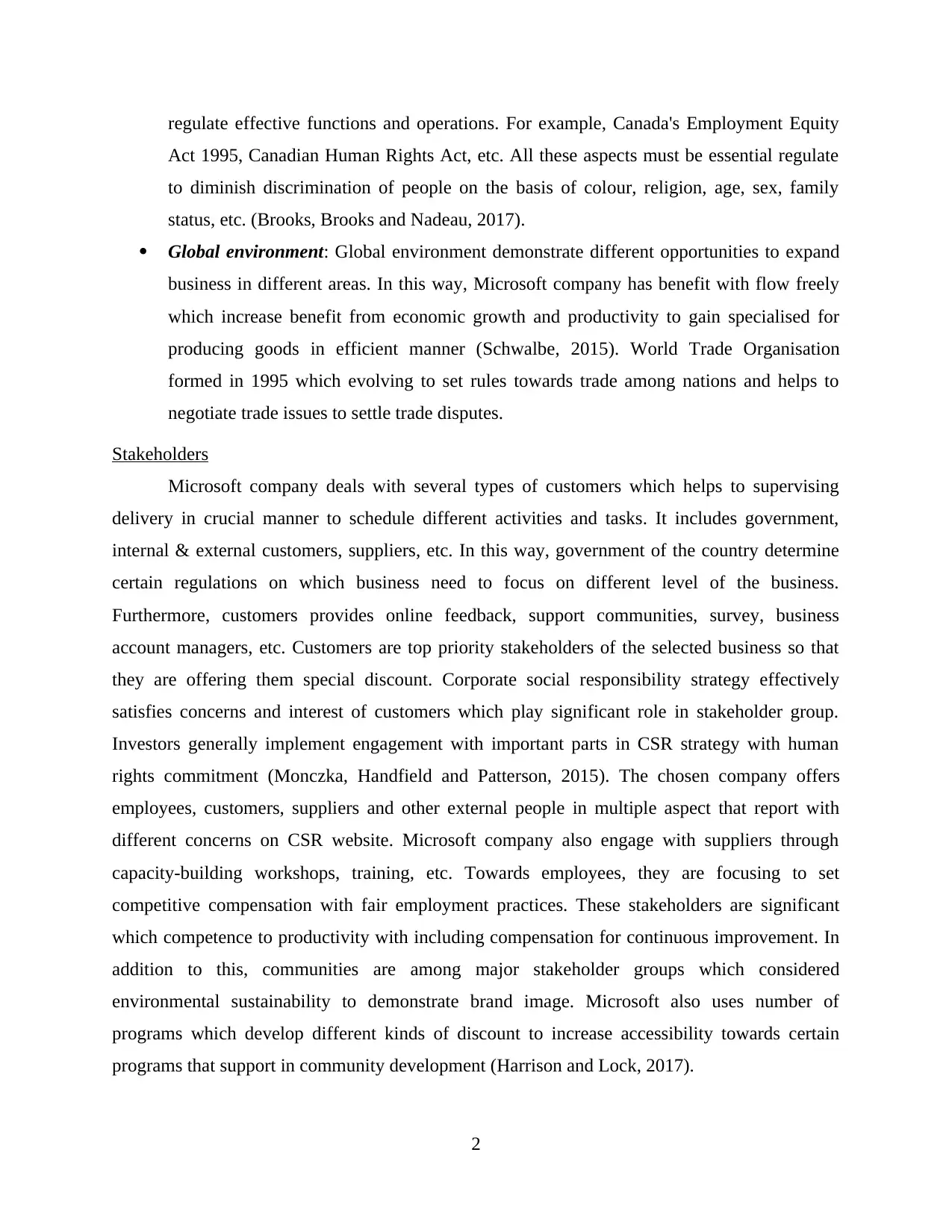
regulate effective functions and operations. For example, Canada's Employment Equity
Act 1995, Canadian Human Rights Act, etc. All these aspects must be essential regulate
to diminish discrimination of people on the basis of colour, religion, age, sex, family
status, etc. (Brooks, Brooks and Nadeau, 2017).
Global environment: Global environment demonstrate different opportunities to expand
business in different areas. In this way, Microsoft company has benefit with flow freely
which increase benefit from economic growth and productivity to gain specialised for
producing goods in efficient manner (Schwalbe, 2015). World Trade Organisation
formed in 1995 which evolving to set rules towards trade among nations and helps to
negotiate trade issues to settle trade disputes.
Stakeholders
Microsoft company deals with several types of customers which helps to supervising
delivery in crucial manner to schedule different activities and tasks. It includes government,
internal & external customers, suppliers, etc. In this way, government of the country determine
certain regulations on which business need to focus on different level of the business.
Furthermore, customers provides online feedback, support communities, survey, business
account managers, etc. Customers are top priority stakeholders of the selected business so that
they are offering them special discount. Corporate social responsibility strategy effectively
satisfies concerns and interest of customers which play significant role in stakeholder group.
Investors generally implement engagement with important parts in CSR strategy with human
rights commitment (Monczka, Handfield and Patterson, 2015). The chosen company offers
employees, customers, suppliers and other external people in multiple aspect that report with
different concerns on CSR website. Microsoft company also engage with suppliers through
capacity-building workshops, training, etc. Towards employees, they are focusing to set
competitive compensation with fair employment practices. These stakeholders are significant
which competence to productivity with including compensation for continuous improvement. In
addition to this, communities are among major stakeholder groups which considered
environmental sustainability to demonstrate brand image. Microsoft also uses number of
programs which develop different kinds of discount to increase accessibility towards certain
programs that support in community development (Harrison and Lock, 2017).
2
Act 1995, Canadian Human Rights Act, etc. All these aspects must be essential regulate
to diminish discrimination of people on the basis of colour, religion, age, sex, family
status, etc. (Brooks, Brooks and Nadeau, 2017).
Global environment: Global environment demonstrate different opportunities to expand
business in different areas. In this way, Microsoft company has benefit with flow freely
which increase benefit from economic growth and productivity to gain specialised for
producing goods in efficient manner (Schwalbe, 2015). World Trade Organisation
formed in 1995 which evolving to set rules towards trade among nations and helps to
negotiate trade issues to settle trade disputes.
Stakeholders
Microsoft company deals with several types of customers which helps to supervising
delivery in crucial manner to schedule different activities and tasks. It includes government,
internal & external customers, suppliers, etc. In this way, government of the country determine
certain regulations on which business need to focus on different level of the business.
Furthermore, customers provides online feedback, support communities, survey, business
account managers, etc. Customers are top priority stakeholders of the selected business so that
they are offering them special discount. Corporate social responsibility strategy effectively
satisfies concerns and interest of customers which play significant role in stakeholder group.
Investors generally implement engagement with important parts in CSR strategy with human
rights commitment (Monczka, Handfield and Patterson, 2015). The chosen company offers
employees, customers, suppliers and other external people in multiple aspect that report with
different concerns on CSR website. Microsoft company also engage with suppliers through
capacity-building workshops, training, etc. Towards employees, they are focusing to set
competitive compensation with fair employment practices. These stakeholders are significant
which competence to productivity with including compensation for continuous improvement. In
addition to this, communities are among major stakeholder groups which considered
environmental sustainability to demonstrate brand image. Microsoft also uses number of
programs which develop different kinds of discount to increase accessibility towards certain
programs that support in community development (Harrison and Lock, 2017).
2
Paraphrase This Document
Need a fresh take? Get an instant paraphrase of this document with our AI Paraphraser
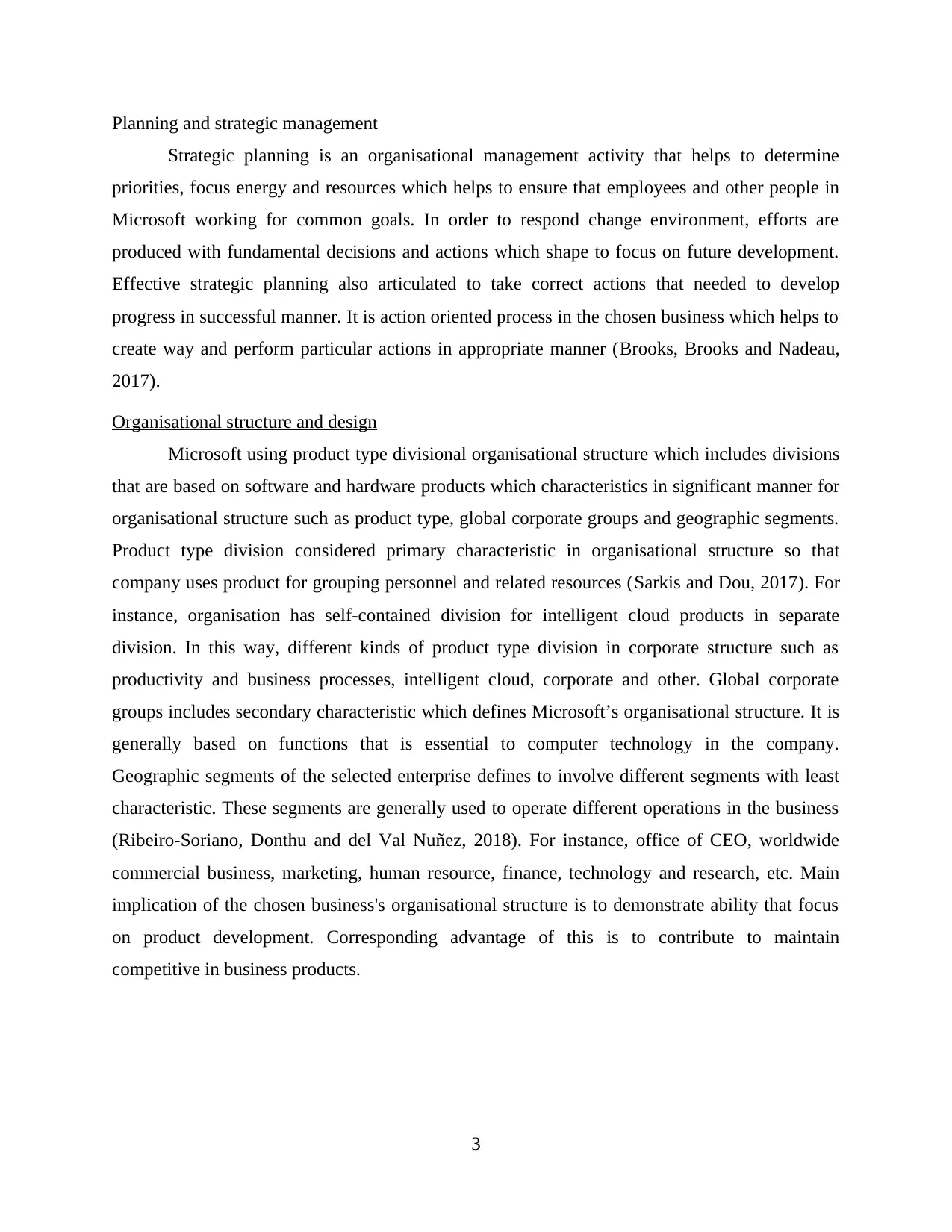
Planning and strategic management
Strategic planning is an organisational management activity that helps to determine
priorities, focus energy and resources which helps to ensure that employees and other people in
Microsoft working for common goals. In order to respond change environment, efforts are
produced with fundamental decisions and actions which shape to focus on future development.
Effective strategic planning also articulated to take correct actions that needed to develop
progress in successful manner. It is action oriented process in the chosen business which helps to
create way and perform particular actions in appropriate manner (Brooks, Brooks and Nadeau,
2017).
Organisational structure and design
Microsoft using product type divisional organisational structure which includes divisions
that are based on software and hardware products which characteristics in significant manner for
organisational structure such as product type, global corporate groups and geographic segments.
Product type division considered primary characteristic in organisational structure so that
company uses product for grouping personnel and related resources (Sarkis and Dou, 2017). For
instance, organisation has self-contained division for intelligent cloud products in separate
division. In this way, different kinds of product type division in corporate structure such as
productivity and business processes, intelligent cloud, corporate and other. Global corporate
groups includes secondary characteristic which defines Microsoft’s organisational structure. It is
generally based on functions that is essential to computer technology in the company.
Geographic segments of the selected enterprise defines to involve different segments with least
characteristic. These segments are generally used to operate different operations in the business
(Ribeiro-Soriano, Donthu and del Val Nuñez, 2018). For instance, office of CEO, worldwide
commercial business, marketing, human resource, finance, technology and research, etc. Main
implication of the chosen business's organisational structure is to demonstrate ability that focus
on product development. Corresponding advantage of this is to contribute to maintain
competitive in business products.
3
Strategic planning is an organisational management activity that helps to determine
priorities, focus energy and resources which helps to ensure that employees and other people in
Microsoft working for common goals. In order to respond change environment, efforts are
produced with fundamental decisions and actions which shape to focus on future development.
Effective strategic planning also articulated to take correct actions that needed to develop
progress in successful manner. It is action oriented process in the chosen business which helps to
create way and perform particular actions in appropriate manner (Brooks, Brooks and Nadeau,
2017).
Organisational structure and design
Microsoft using product type divisional organisational structure which includes divisions
that are based on software and hardware products which characteristics in significant manner for
organisational structure such as product type, global corporate groups and geographic segments.
Product type division considered primary characteristic in organisational structure so that
company uses product for grouping personnel and related resources (Sarkis and Dou, 2017). For
instance, organisation has self-contained division for intelligent cloud products in separate
division. In this way, different kinds of product type division in corporate structure such as
productivity and business processes, intelligent cloud, corporate and other. Global corporate
groups includes secondary characteristic which defines Microsoft’s organisational structure. It is
generally based on functions that is essential to computer technology in the company.
Geographic segments of the selected enterprise defines to involve different segments with least
characteristic. These segments are generally used to operate different operations in the business
(Ribeiro-Soriano, Donthu and del Val Nuñez, 2018). For instance, office of CEO, worldwide
commercial business, marketing, human resource, finance, technology and research, etc. Main
implication of the chosen business's organisational structure is to demonstrate ability that focus
on product development. Corresponding advantage of this is to contribute to maintain
competitive in business products.
3
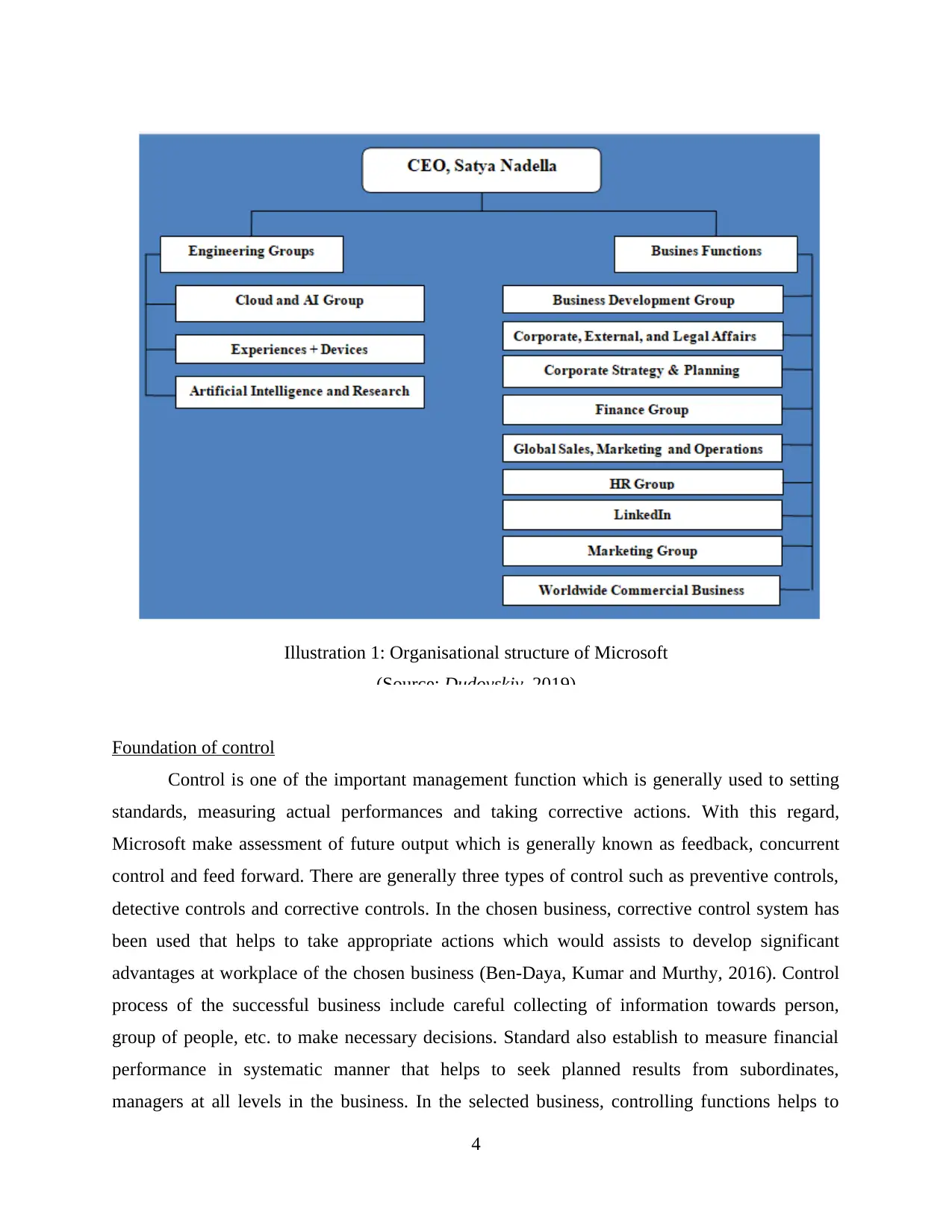
Foundation of control
Control is one of the important management function which is generally used to setting
standards, measuring actual performances and taking corrective actions. With this regard,
Microsoft make assessment of future output which is generally known as feedback, concurrent
control and feed forward. There are generally three types of control such as preventive controls,
detective controls and corrective controls. In the chosen business, corrective control system has
been used that helps to take appropriate actions which would assists to develop significant
advantages at workplace of the chosen business (Ben-Daya, Kumar and Murthy, 2016). Control
process of the successful business include careful collecting of information towards person,
group of people, etc. to make necessary decisions. Standard also establish to measure financial
performance in systematic manner that helps to seek planned results from subordinates,
managers at all levels in the business. In the selected business, controlling functions helps to
4
Illustration 1: Organisational structure of Microsoft
(Source: Dudovskiy, 2019)
Control is one of the important management function which is generally used to setting
standards, measuring actual performances and taking corrective actions. With this regard,
Microsoft make assessment of future output which is generally known as feedback, concurrent
control and feed forward. There are generally three types of control such as preventive controls,
detective controls and corrective controls. In the chosen business, corrective control system has
been used that helps to take appropriate actions which would assists to develop significant
advantages at workplace of the chosen business (Ben-Daya, Kumar and Murthy, 2016). Control
process of the successful business include careful collecting of information towards person,
group of people, etc. to make necessary decisions. Standard also establish to measure financial
performance in systematic manner that helps to seek planned results from subordinates,
managers at all levels in the business. In the selected business, controlling functions helps to
4
Illustration 1: Organisational structure of Microsoft
(Source: Dudovskiy, 2019)
⊘ This is a preview!⊘
Do you want full access?
Subscribe today to unlock all pages.

Trusted by 1+ million students worldwide
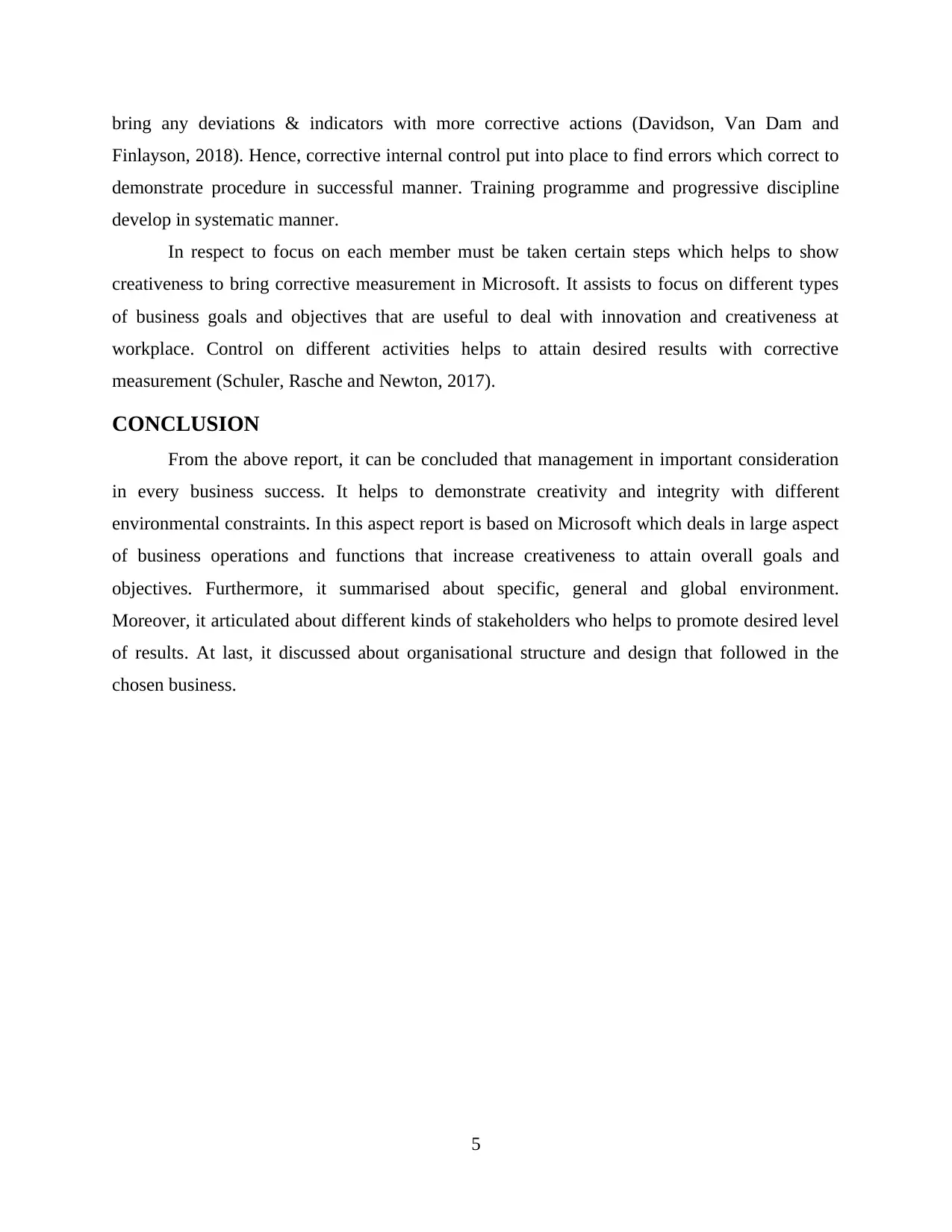
bring any deviations & indicators with more corrective actions (Davidson, Van Dam and
Finlayson, 2018). Hence, corrective internal control put into place to find errors which correct to
demonstrate procedure in successful manner. Training programme and progressive discipline
develop in systematic manner.
In respect to focus on each member must be taken certain steps which helps to show
creativeness to bring corrective measurement in Microsoft. It assists to focus on different types
of business goals and objectives that are useful to deal with innovation and creativeness at
workplace. Control on different activities helps to attain desired results with corrective
measurement (Schuler, Rasche and Newton, 2017).
CONCLUSION
From the above report, it can be concluded that management in important consideration
in every business success. It helps to demonstrate creativity and integrity with different
environmental constraints. In this aspect report is based on Microsoft which deals in large aspect
of business operations and functions that increase creativeness to attain overall goals and
objectives. Furthermore, it summarised about specific, general and global environment.
Moreover, it articulated about different kinds of stakeholders who helps to promote desired level
of results. At last, it discussed about organisational structure and design that followed in the
chosen business.
5
Finlayson, 2018). Hence, corrective internal control put into place to find errors which correct to
demonstrate procedure in successful manner. Training programme and progressive discipline
develop in systematic manner.
In respect to focus on each member must be taken certain steps which helps to show
creativeness to bring corrective measurement in Microsoft. It assists to focus on different types
of business goals and objectives that are useful to deal with innovation and creativeness at
workplace. Control on different activities helps to attain desired results with corrective
measurement (Schuler, Rasche and Newton, 2017).
CONCLUSION
From the above report, it can be concluded that management in important consideration
in every business success. It helps to demonstrate creativity and integrity with different
environmental constraints. In this aspect report is based on Microsoft which deals in large aspect
of business operations and functions that increase creativeness to attain overall goals and
objectives. Furthermore, it summarised about specific, general and global environment.
Moreover, it articulated about different kinds of stakeholders who helps to promote desired level
of results. At last, it discussed about organisational structure and design that followed in the
chosen business.
5
Paraphrase This Document
Need a fresh take? Get an instant paraphrase of this document with our AI Paraphraser
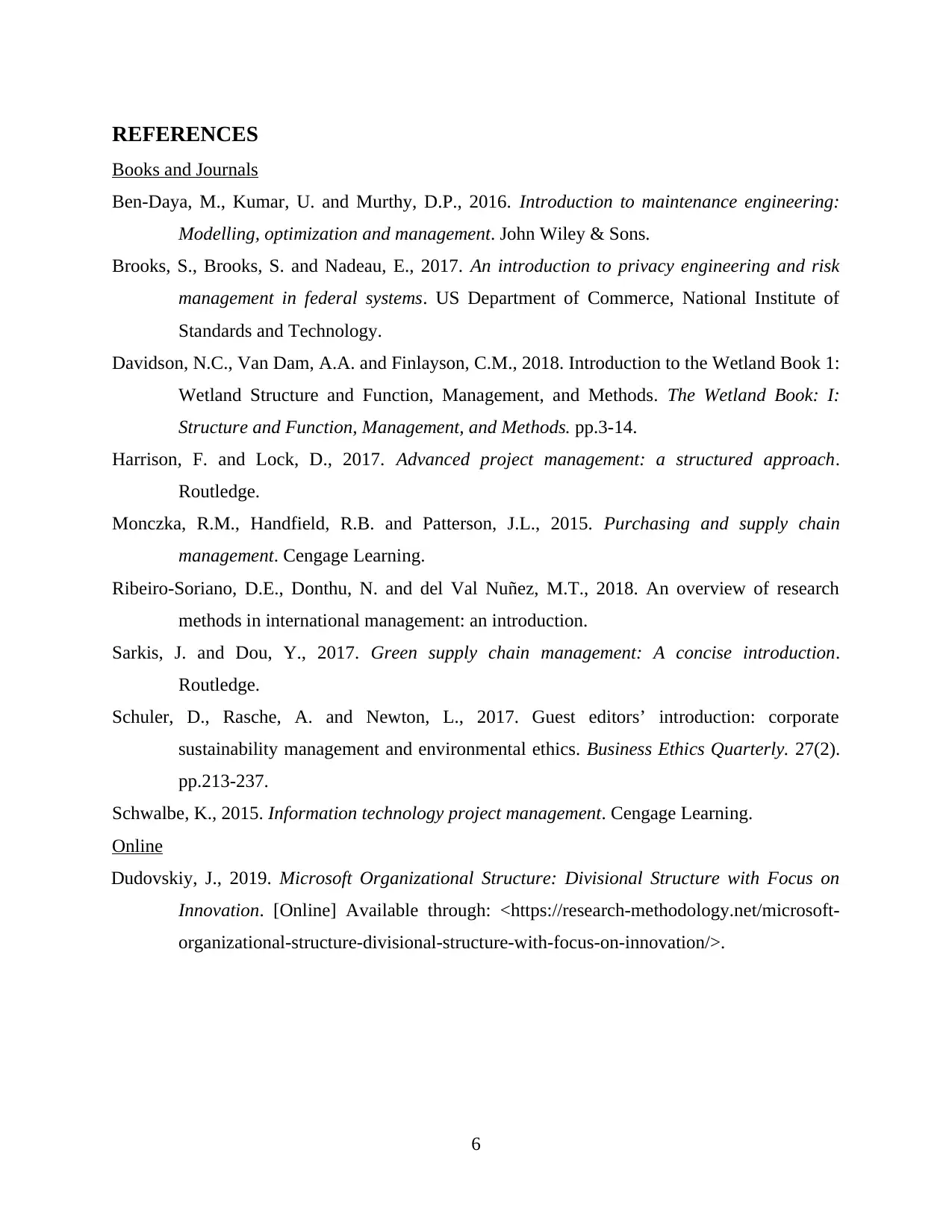
REFERENCES
Books and Journals
Ben-Daya, M., Kumar, U. and Murthy, D.P., 2016. Introduction to maintenance engineering:
Modelling, optimization and management. John Wiley & Sons.
Brooks, S., Brooks, S. and Nadeau, E., 2017. An introduction to privacy engineering and risk
management in federal systems. US Department of Commerce, National Institute of
Standards and Technology.
Davidson, N.C., Van Dam, A.A. and Finlayson, C.M., 2018. Introduction to the Wetland Book 1:
Wetland Structure and Function, Management, and Methods. The Wetland Book: I:
Structure and Function, Management, and Methods. pp.3-14.
Harrison, F. and Lock, D., 2017. Advanced project management: a structured approach.
Routledge.
Monczka, R.M., Handfield, R.B. and Patterson, J.L., 2015. Purchasing and supply chain
management. Cengage Learning.
Ribeiro-Soriano, D.E., Donthu, N. and del Val Nuñez, M.T., 2018. An overview of research
methods in international management: an introduction.
Sarkis, J. and Dou, Y., 2017. Green supply chain management: A concise introduction.
Routledge.
Schuler, D., Rasche, A. and Newton, L., 2017. Guest editors’ introduction: corporate
sustainability management and environmental ethics. Business Ethics Quarterly. 27(2).
pp.213-237.
Schwalbe, K., 2015. Information technology project management. Cengage Learning.
Online
Dudovskiy, J., 2019. Microsoft Organizational Structure: Divisional Structure with Focus on
Innovation. [Online] Available through: <https://research-methodology.net/microsoft-
organizational-structure-divisional-structure-with-focus-on-innovation/>.
6
Books and Journals
Ben-Daya, M., Kumar, U. and Murthy, D.P., 2016. Introduction to maintenance engineering:
Modelling, optimization and management. John Wiley & Sons.
Brooks, S., Brooks, S. and Nadeau, E., 2017. An introduction to privacy engineering and risk
management in federal systems. US Department of Commerce, National Institute of
Standards and Technology.
Davidson, N.C., Van Dam, A.A. and Finlayson, C.M., 2018. Introduction to the Wetland Book 1:
Wetland Structure and Function, Management, and Methods. The Wetland Book: I:
Structure and Function, Management, and Methods. pp.3-14.
Harrison, F. and Lock, D., 2017. Advanced project management: a structured approach.
Routledge.
Monczka, R.M., Handfield, R.B. and Patterson, J.L., 2015. Purchasing and supply chain
management. Cengage Learning.
Ribeiro-Soriano, D.E., Donthu, N. and del Val Nuñez, M.T., 2018. An overview of research
methods in international management: an introduction.
Sarkis, J. and Dou, Y., 2017. Green supply chain management: A concise introduction.
Routledge.
Schuler, D., Rasche, A. and Newton, L., 2017. Guest editors’ introduction: corporate
sustainability management and environmental ethics. Business Ethics Quarterly. 27(2).
pp.213-237.
Schwalbe, K., 2015. Information technology project management. Cengage Learning.
Online
Dudovskiy, J., 2019. Microsoft Organizational Structure: Divisional Structure with Focus on
Innovation. [Online] Available through: <https://research-methodology.net/microsoft-
organizational-structure-divisional-structure-with-focus-on-innovation/>.
6
1 out of 8
Related Documents
Your All-in-One AI-Powered Toolkit for Academic Success.
+13062052269
info@desklib.com
Available 24*7 on WhatsApp / Email
![[object Object]](/_next/static/media/star-bottom.7253800d.svg)
Unlock your academic potential
Copyright © 2020–2025 A2Z Services. All Rights Reserved. Developed and managed by ZUCOL.




